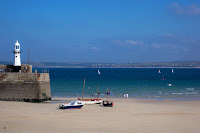
At Lucy's suggestion, Chad, Elizabeth, and I hopped on a bus last weekend and went to Tewkesbury. The village isn't really that far from Cheltenham, maybe 20 - 25 minutes each way, and our fare only cost 50 pence each (with student ID). Honestly, I didn't even know this place existed before I saw the road signs on High Street, so really, this was a learning experience for me.
 But fear not, I drudged around the Internet (yes, even to Wikipedia), and I think I can sum up the highlights. Tewkesbury is named after Theoc, a Saxon hermit in the 7th century. JSTOR says it went something like this: "The name of ths hermit was Theoc, or Theocus. Hence we get Theocsburg, Theotisbryg, Teodechesberie, Theokusburia, all these variants being now softened into Tewkesbury" (D. Crotchet, 1904). Personally I'm not convinced, but whatever, it's a nice piece of fictory.
But fear not, I drudged around the Internet (yes, even to Wikipedia), and I think I can sum up the highlights. Tewkesbury is named after Theoc, a Saxon hermit in the 7th century. JSTOR says it went something like this: "The name of ths hermit was Theoc, or Theocus. Hence we get Theocsburg, Theotisbryg, Teodechesberie, Theokusburia, all these variants being now softened into Tewkesbury" (D. Crotchet, 1904). Personally I'm not convinced, but whatever, it's a nice piece of fictory. Because it's located on a flood plane (thanks to the Rivers Severn and Avon), expansion and urbanization has been nearly impossible, leaving Tewkesbury almost exactly as it was 500 years ago. In a similar stroke of luck, many of the timbered, black and white Tudor buildings of that time period are also standing. That, combined with its impressive 12th Century abbey, makes it one of those Very Important places they take students to learn about the middle ages.
Because it's located on a flood plane (thanks to the Rivers Severn and Avon), expansion and urbanization has been nearly impossible, leaving Tewkesbury almost exactly as it was 500 years ago. In a similar stroke of luck, many of the timbered, black and white Tudor buildings of that time period are also standing. That, combined with its impressive 12th Century abbey, makes it one of those Very Important places they take students to learn about the middle ages.Now for the bloody parts: The Battle of Tewkesbury! (I bet you'll never guess where that took place.) Basically, this battle put an end to the Lancaster family's ambitions to rule during The War of the Roses. Bad York, bad Lancaster. No bickering at the table. After the battle, things were more or less peaceful for 14 years until Henry VIII took over and started the Tudor dynasty. They re-enact the battle each year at Tewkesbury's medieval festival, which we were all unfortunate enough to miss.
Edward of Westminster (AKA little Eddie Lancaster) allied himself with those pesky Warwicks from the last castle we visited, and got himself killed in the battle. Wikipedia tells me he's the
 only Prince of Wales ever to do so. His widow becomes King Richard III's Queen Anne, but outside of Shakespeare's version I can't say I'm overly concerned with it. Edward of Lancaster is buried in the Abbey.
only Prince of Wales ever to do so. His widow becomes King Richard III's Queen Anne, but outside of Shakespeare's version I can't say I'm overly concerned with it. Edward of Lancaster is buried in the Abbey.
I think I inadvertently stood on his grave when I was photographing the altar - oops.
Tewkesbury Abbey is a Norman building, originally part of a monastery before Henry VIII did away with them. To preserve it, the people bought the building - for what I can only assume was a very large sum in those days - and started using it as their parish. The Abbey also houses some very elaborate medieval mausoleums, and we saw parts of the garden walls that clearly had recycled stone (some with eroded carvings) from an older building that used to stand there.

We wandered around their town center, taking the left fork at The Cross (the Tewkesbury War Memorial), and found a small door about 3 blocks in on the right. It opened into a rather large alley lined with books, and two more haphazard doors opened into respectably large rooms (also full of books). It was a fairly nice used book shop - lots of history texts and very old manuscripts recounting the history and genealogies of Gloucester. I didn't find anything I couldn't live without, but it was still a nice discovery.
There were a lot of little museums we didn't get a chance to explore, but I think they would have been really fun. If I ever go into Tewkesbury again (which is likely, given the proximity) I would probably make a special effort to see them. At first glance they all look kind of like the rip-off tourist magnets that display wax mannequins wearing period clothing, but I've read a few reviews since I started writing this, and it looks like I was mistaken. Shocking, I know.












































